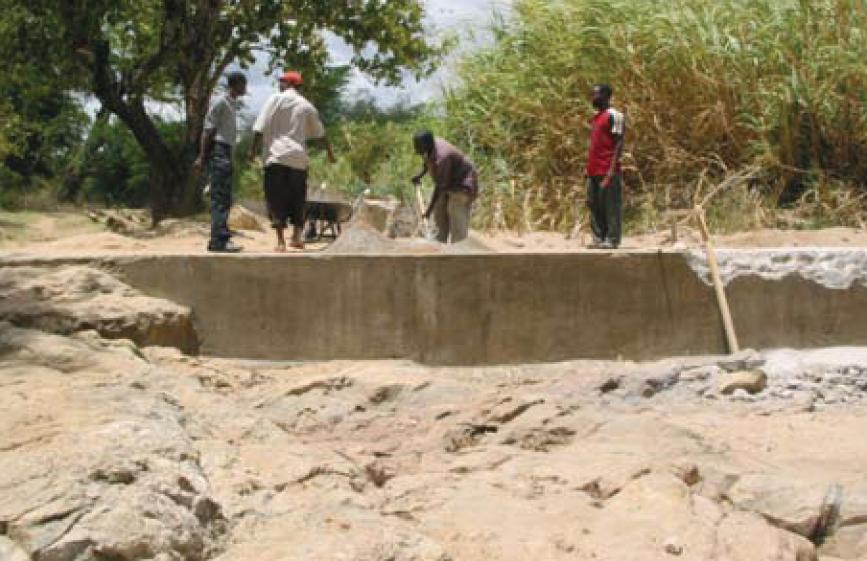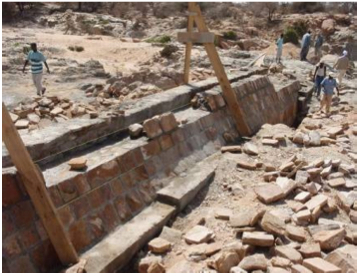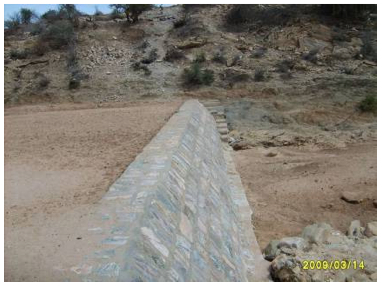Difference between revisions of "वाटर पोर्टल / वर्षाजल संचयन / भूजल पुनर्भरण / रेत बांध - सैंडडैम"
| Line 128: | Line 128: | ||
निर्माण, परिचालन और रखरखाव जैसे सभी स्तरों पर सफलता सुनिश्चित करने के लिए स्थानीय समुदाय को समुचित प्रशिक्षण दिया जाना चाहिए ताकि वह बांध का प्रबंधन और उसका रखरखाव कर सके. कैचमेंट स्तर पर नियोजन और प्रबंधन को बढ़ावा दिया जाना चाहिए ताकि विभिन्न समूहों का एक ही स्रोत में निहित स्वार्थ बना रहे. वे मिट्टी और पानी के संरक्षण, खाद्यान्न उत्पादन और स्वास्थ्य सुधार के मसलों पर काम कर सकते हैं. पिछले अनुभवों से यही पता चलता है कि बांध का निर्माण कार्य पूरा होने के बाद समितियां प्रभावी ढंग से काम करना बंद कर देती हैं. बांध निर्माण में ज्यादा समय लिया जाए तो कैचमेंट आधारित संघ बनाने और उसे कामकाज शुरू करने में मदद मिल सकती है. | निर्माण, परिचालन और रखरखाव जैसे सभी स्तरों पर सफलता सुनिश्चित करने के लिए स्थानीय समुदाय को समुचित प्रशिक्षण दिया जाना चाहिए ताकि वह बांध का प्रबंधन और उसका रखरखाव कर सके. कैचमेंट स्तर पर नियोजन और प्रबंधन को बढ़ावा दिया जाना चाहिए ताकि विभिन्न समूहों का एक ही स्रोत में निहित स्वार्थ बना रहे. वे मिट्टी और पानी के संरक्षण, खाद्यान्न उत्पादन और स्वास्थ्य सुधार के मसलों पर काम कर सकते हैं. पिछले अनुभवों से यही पता चलता है कि बांध का निर्माण कार्य पूरा होने के बाद समितियां प्रभावी ढंग से काम करना बंद कर देती हैं. बांध निर्माण में ज्यादा समय लिया जाए तो कैचमेंट आधारित संघ बनाने और उसे कामकाज शुरू करने में मदद मिल सकती है. | ||
| − | + | ब्रिक्की ऐंड ब्रेडरो ने अपने प्रकाशन ''[http://www.washdoc.info/docsearch/title/117705 लिंकिंग टेक्रॉलजी च्वाइस विद ऑपरेशन ऐंड मेंटनेंस इन द कंटेक्स्ट ऑफ कम्युनिटिी वाटर सप्लाई ऐंड सेनिटेशन: अ रिफ्रेंस डॉक्युमेंट फॉर प्लानर्स ऐंड प्रोजेक्ट स्टाफ]'', में परिचालन और रखरखाव गतिविधियों के लिए निम्र अनुशंसाएं की हैं: | |
| − | |||
| − | |||
[[File:SandDam_OM.jpg|none|600px|]] | [[File:SandDam_OM.jpg|none|600px|]] | ||
Revision as of 13:30, 6 December 2015
| |
|
|
|
|
|
|
|
|
रेत बांध (सैंडडैम) साधारण, कम लागत और कम रखरखाव वाली ऐसी वर्षा जल संरक्षण तकनीक है जिसका जगह-जगह अनुकरण किया जा सकता है. यह घरेलू उपयोग और पशुपालन के लिए साफ-स्वच्छ पानी मुहैया कराती है और दुनिया भर के अर्द्ध शुष्क इलाकों में उपयोगी है.
जिन इलाकों में बारिश अनिश्चित होती है वहां अक्सर नदियों के तटवर्ती इलाके में काफी रेत इकट्ठी होती रहती है. इन जगहों पर वर्षा के तत्काल बाद पानी बहुत तेजी से बह जाता है. तेज बहाव वाले दिनों में बहुत बड़ी मात्रा में बालू भी बहकर निचली धारा वाले इलाके में पहुंचती है. कुछ बालू ऊपरी धाराओं में चट्टानों के बीच भी फंस जाती है. ये क्षेत्र प्राकृतिक तौर पर जल भंडारण वाले जल क्षेत्र निर्मित करते हैं. रेत बांध (सैंडडैम) तकनीक से इस पानी को एकत्रित किया जाता है और मौजूदा भंडारण क्षमता में भी इजाफा किया जाता है.
प्राकृतिक संग्रह स्थानों पर पानी आमतौर पर पीने के लिहाज से साफ ही होता है लेकिन उसकी मात्रा बहुत कम होती है और वह तत्काल खत्म भी हो जाता है. रेत बांध (सैंडडैम) प्राकृतिक रेतीले जल भंडारण स्थानों में कृत्रिम तौर पर सुधार करके बनाए जाते हैं ताकि अधिक से अधिक मात्रा में भूजल रिचार्ज किया जा सके और उस पानी को प्रयोग में लाया जा सके. कंक्रीट, मिट्टी और पत्थरों का उपयोग करके इस बांध को बनाया जाता है ताकि बाढ़ आदि के दिनों में पानी को सुरक्षित ढंग से भंडारित किया जा सके. इस पानी को सूखे दिनों में प्रयोग में लाया जा सकता है.
अगर सही जगह का चुनाव किया जाए तो रेत बांध (सैंडडैम) में 6000 घन मीटर से अधिक पानी एकत्रित हो सकता है.
रेत बांध (सैंडडैम) परियोजनाओं ने न केवल पानी की उपलब्धता में सुधार किया है बल्कि उनकी बदौलत समुदायों को सामाजिक और आर्थिक तौर पर भी मदद मिली है. स्थानीय लोगों को बांधों के निर्माण में शामिल किया जाता है. इसके अलावा वे उनके रखरखाव, वित्तीय पंबंधन और प्राकृतिक संसाधन प्रबंधन आदि के क्षेत्र में भी काम करते हैं.
किन तरह की परिस्थतियों में यह तकनीक काम में आती है
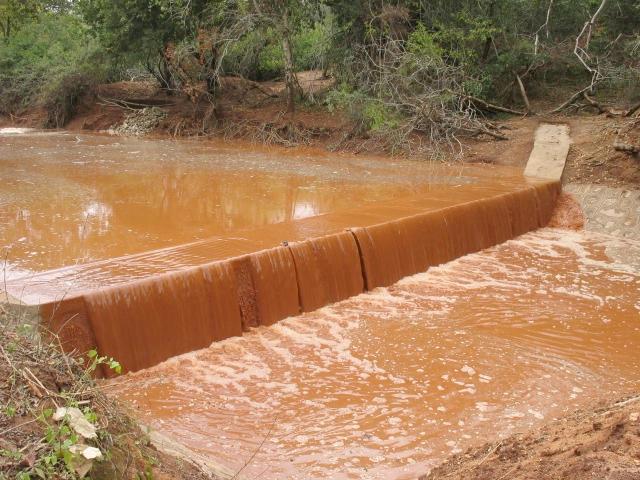
रेत बांध (सैंडडैम) का निर्माण घरेलू जरूरतों, सामुदायिक जरूरतों और यहां तक कि नगरपालिका संबंधी जरूरतों के हिसाब से भी किया जा सकता है. ऐसे अनेक उदाहरण हैं जहां रेत बांधों (सैंडडैम्स) को रिसाव वाले क्षेत्रों, सामान्य कुओं और पंप स्टेशनों आदि से जोड़कर पाइप के माध्यम से बड़े पैमाने पर जलापूर्ति की गई.
बहरहाल, ऐसे बांध के लिए एकदम उपयुक्त स्थान का चयन करने में और परियोजना को भौतिक रूप से व्यवहार्य बनाने तथा स्थानीय समुदाय की सामाजिक परिस्थितियों के अनुकूल बनाने में विशेषज्ञों की सलाह की आवश्यकता होती है. बांध के लिए निर्धारित प्रत्येक क्षेत्र में एक मिस्त्री के होने मात्र से सफलता की दर काफी हद तक बढ़ जाती है. भौतिक आधार पर देखा जाए तो तय की गई गह बांध के निर्माण के लिए एकदम उपयुक्त होनी चाहिए, वहां से पीने लायक साफ पानी मिलना चाहिए और पानी की उपलब्धता बढ़ाने के लिए बालू का अवसादन होना चाहिए. पहली बात तो यह तय किया जाना चाहिए कि उपयुक्त नदी चुनी गई है या नहीं उसके बाद नदी तट के सबसे अच्छे स्थान का चुनाव किया जाना चाहिए और आखिर में खनन के लिए जगह तय की जानी चाहिए.
आमतौर पर बांध को ऊंचे स्थान पर बालू वाले नदी तट की आवश्यकता होती है. ऐसे तट को प्राथमिकता दी जाती है जहां मोटी बालू और पारगम्य चट्टानें हों. नदी मौसमी भी हो सकती है लेकिन उसका बहाव सुस्पष्ट होना चाहिए. इसका निर्धारण नदी के आसपास उगे पेड़ पौधों को देखकर किया जा सकता है. नदी बहुत अधिक चौड़ी नहीं होनी चाहिए और उसके दो ऊंचे किनारे होने चाहिए.
यह सुनिश्चित किया जाना चाहिए कि रेत बांध (सैंडडैम) का निर्माण ऐसे इलाके में नहीं किया जा रहा है जहां पानी ढांचे को पार कर जाए. नदी के तट समान और पर्याप्त ऊंचाई वाले होने चाहिए. बांध को ऐसी जगह पर नहीं बनाया जाना चाहिए जहां नदी मुड़ती हो.
इसके अलावा ऐसी जगह चुनी जानी चाहिए जहां पानी का किसी तरह का रिसाव न होता हो:
- On impervious bedrock or clay rather than rock with fractures. A good indicator is whether there is some preexisting subsurface flow in the dry season or not and if there are large stones & boulders seen in the riverbed. Extra care should be taken when siting as seepage can occur under the dam in such cases.
- On the base layer rather than on the intermediate clay lens within sand.
- Between defined banks with no old riverbeds on either side which could allow sub-surface water around dam edge.
- दरारों वाली चट्टानों के बजाय अपारगम्य चट्टानों या मिट्टी का चुनाव करना चाहिए. एक अच्छा संकेतक यह देखना है कि सूखे दिनों में पहले से कोई बहाव है या नहीं. यह भी कि नदी तट पर बड़े आकार की चट्टानें और पत्थर आदि हैं या नहीं? ऐसे मामलों में अतिरिक्त सावधानी बरतनी होती है क्योंकि यहां रिसाव की आशंका रहती है.
- ऐसी जगहों का चयन किया जाना चाहिए जहां ढलान बालू को आकर्षित करने वाली हो बजाय कि उसे बहाने वाली. 0.45 मीटर प्रति सेकंड के बहाव वाली नदी में रेत का बहाव कम होता है और यह माना जा सकता है कि ऐसे बहाव वाले इलाकों में बहुत ज्यादा छोटे आकार के कण और गाद आदि नदी तल में हो सकते हैं. सपाट ढलान का अर्थ है चौड़े नदी तट. रेत बांध (सैंडडैम) के लिए इनका आकार 25 मीटर से अधिक चौड़ा नहीं होना चाहिए. आदर्श ढलान 0.125 प्रतिशत से 4 प्रतिशत के बीच होनी चाहिए लेकिन यह इससे अधिक भी हो सकती है. परंतु तब बालू जमा बालू की मात्रा कम होगी. एक आसान परीक्षण यह भी हो सकता है कि एक रेत विश्लेषक की मदद लेकर आकार के वितरण, सांद्रता आदि का परीक्षण किया जाए. मध्यम आकार की बालू को इस लिहाज से सबसे बेहतर माना जा सकता है.
जिन जगहों पर नदी संकरी हो और जहां भूजल प्रवाह पर प्राकृतिक बाधा हो उनका चयन किया जाना चाहिए. ऐसा करने से निर्माण की लागत बहुत कम होती है जबकि बालू अधिकाधिक मात्रा में खुदबखुद मौजूद रहती है. उन स्थानों का चयन करने से बचा जाना चाहिए जहां हेलाइट (सफेद और गुलाबी चट्टानें) नदी तट की ऊपरी धारा में मौजूद हों. क्योंकि इनकी वजह से पानी में खारापन आ सकता है.
एक ही नदी पर कई बांध बनाने का फायदा यह होता है कि सभी लोग एक ही जल स्रोत का इस्तेमाल नहीं करते हैं और इस तरह क्षेत्र को पर्यावरणीय नुकसान नहीं पहुंचता है. बहरहाल, अगर बांध एक दूसरे से बहुत करीब स्थित हुए तो उनका प्रभाव क्षेत्र एक दूसरे को दरकिनार करना शुरू कर देता है. इससे आमतौर पर जलस्तर में इजाफा देखने को मिलता है लेकिन कुल पानी की मात्रा कम होने लगती है. क्षेत्रवार आधार पर देखा जाए तो मात्रा बहुत मायने रखती है इसलिए बांधों के बीच उचित दूरी रखनी चाहिए. जगह-जगह के आधार पर यह दूरी 350 मीटर से 700 मीटर तक हो सकती है.
ये परिस्थितियां तथा जलवायु, पत्थरों की मौजूदगी या नदी तट की ढाल आदि का विस्तृत विश्लेषण करके ही जगह की सुयोग्यता का निर्धारण किया जा सकता है. इसके अलावा हालांकि इसमें कृत्रिम तौर पर सुधार किया जा सकता है लेकिन पानी की गुणवत्ता कम से कम पीने के लायक तो होनी ही चाहिए.
Site in areas where gradient is suitable to get sand rather than silt. A flow of at least 0.45 m/s river flow means less silt deposition, and such areas will be where there is a suitable gradient – too flat and there will be too many small particles and silt. Flatter gradients also mean wider riverbeds, and for sand dams it should really be limited to 25 metres width. An optimum gradient is said to occur between 0.125% and 4% but can be higher than this but then the sand volume stored is less. An easier field test might be to do a sand analysis to find size distribution, or a porosity & specific yield test from which one can extrapolate the likely sand type. Medium sand will have the best balance between porosity and specific yield, and is therefore the type that is needed.
Site where river is narrower and where there is a natural barrier to groundwater flow. This results in cheaper construction while maximizing sand already present. Such barriers can be found by seeing where water will remain in scoop holes after rains, or through probing, augering & trial pits, or other techniques such as drilling with air compressor.
Avoid siting where halite (white & pink rocks) is present in riverbanks upstream. These may make the water saline.
Have a sequence of dams in the same river to avoid everyone using a single source with possible ecological damage as a result. However, having dams too close together means their areas of influence overlap. This enables water levels to rise in general, but the total quantity of water available decreases. Quantity is more important regionally, therefore minimum distances might be employed between dams (350m either side of dam was zone of influence in Kenya with a 700m minimum, but this might vary according to site).
These conditions and also others related to, for example; climate, presence of boulders, or gradient of the riverbed must be analyzed in detail to determine suitability of the site. Also, though it can be artificially improved, the water quality must be good enough for drinking (not too saline, contaminated, etc.)
| Advantages | Disadvantages |
|---|---|
|
- Year-round source of good quality water and groundwater recharge |
- Site-specific technology – not suitable everywhere. |
Resilience to changes in the environment
Drought
Effects of drought: Can dry up; Water yields low.
Underlying causes of effects: Less recharge of aquifer due to less rainfall. Increasing population & water demand; Size of aquifers – e.g. limited sand volume; Too much silt accumulates behind dam; Wells not sunk deep enough into water table; Incorrect siting creates leaking dams.
To increase resiliency of WASH system: Competent siting & construction; Build sand dam in stages to reduce silt; Soil & water conservation techniques in upper part of catchment; Dig abstraction wells/pipes deeper.
More information on managing drought: Resilient WASH systems in drought-prone areas.
Floods
Sand dams require careful maintenance, and immediate repair, as flooding causes hundreds of tons of water to fall over the dam wall and onto the spill-over apron. Flood water may also spill over and erode the wing walls and, perhaps, even over the riverbanks during heavy rains. When determining the dam and spillway height at the selected location, it is very important that the water level and flood line remain below the riverbanks after construction of the dam, or that flooding will not lead to problems up or downstream of the dam. If the flood level is higher than the riverbanks, construction of a dam is not advisable.
Construction, operations and maintenance
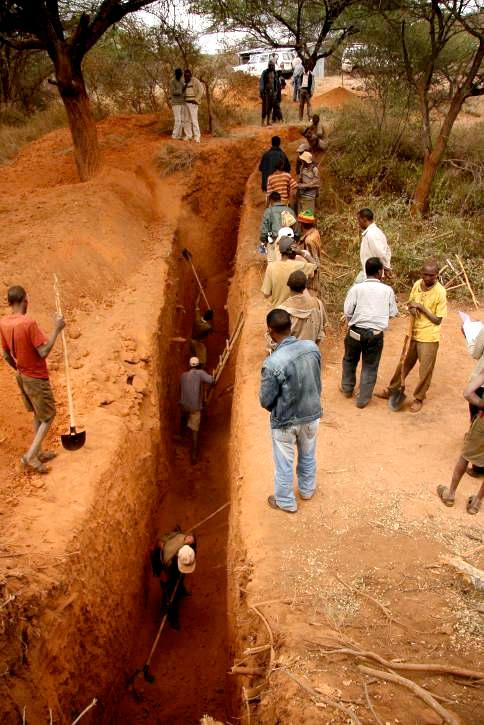
First a trench needs to be dug. Its position is marked out using pegs. Then it is excavated and the soil placed downstream. It can also be dug out into bedrock. It should then be checked for weathering zones and cracks. Round bars are placed vertically along the trench to reinforce it. Then a foundation is laid consisting of 2 layers of cement with barbed wire in between. Once this has set, the trench is filled with masonry or mortar and hardcore. The wing walls and final dam wall can then be constructed. Finally any exposed parts of the construction are plastered.
Building the sand dam (and wing wall)
General advice on cement: A common cause of cracks in structures and linings (e.g. in tanks, dams, waterways, wells) is errors in mixing and applying the cement. First of all, it is important that only pure ingredients are used: clean water, clean sand, clean rocks. The materials have to be mixed very thoroughly. Secondly, the amount of water during mixing needs to minimal: the concrete or cement needs to be just workable, on the dry side even, and not fluid. Thirdly, it is essential that during curing the cement or concrete is kept moist at all times, for at least a week. Structures should be covered with plastic, large leaves or other materials during the curing period, and kept wet regularly.
Specific advice
- Timing is important: dams should be built during the dry season, but don’t build dams too close to the rains in order to avoid the trench filling up with water or the dam being washed away.
- The method depends on the type of dam and the type of ground. The construction of sand dams in cascades improves total storage and efficiency and minimizes seepage losses. Dams made of concrete, stone-masonry (cheapest and easiest) and brickwork require skilled labour for construction, but are stronger and have a longer lifespan.
- Usually sand dams are built onto a rock layer, but where there is no rock and only clay, it can still work but as long as the foundation is keyed into the clay layer and where the wall does not protrude more than 0.5m above original sand level, otherwise there is a risk the structure overturns during a flood event.
- Key into banks or construct wing walls to avoid erosion around edges of the sand dam. Where wing walls are built, a good technique is to start with the wing walls and work inwards to the centre, since community enthusiasm lags by the time wing walls are constructed (if not built first), yet they are essential to proper functioning. Length of the wing wall varies according to bank characteristic: loose riverbanks, 7 metres; hard soils, 5 metres; hard & impermeable soils or rocks, wing wall is not needed. Planting napier grass along upstream riverbanks controls erosion and fixes the course of the river in a flood.
- The height of wall built before each flood event should not exceed accumulation rate of coarse to medium sand during that flood event, otherwise ponding & silt deposition will occur, which can lower specific yield and higher capillarity, then lead to limited extraction rates in wells upstream and more water lost to evaporation. Dams at 1.3m depth showed that where finer material content (0.063 mm or less) is increased, specific yield is known to decrease remarkably. Accumulation rate and therefore height varies according to location and should be adjusted at each site after the first flood event demonstrates the rate of accumulation. Height per stage will probably be between 0.3 metre and 1 metre per stage according to experience from past projects. Some silt deposition will always occur as velocities decrease toward the end of the flood event; the idea is to limit its quantity in final sand volume.
- Avoid downstream erosion problems by making a protective slab (stilling basin) at the base of large stones set in concrete. Dimensions to be designed, but is not necessary where there is exposed rock bar downstream.
- In upstream parts of a catchment it is recommended that sand dams are always built in stages, since the availability of coarse material is generally limited and base flow is small or absent (base flow = sub-surface flow which aids surface flow so that silt/clay can still be flushed away once rainfall stops, rather than sinking directly into the sand bed). It has also been suggested that to build in stages over several years is also more beneficial for functioning of dam committees. Build them within a spillway, which was part of the first stage & wing wall construction.
Water extraction
After the dam is built, an outlet for water extraction must be constructed for drinking, agriculture, etc. Hand dug scoop holes are the simplest possibility, however the water can easily be contaminated. Covered shallow wells, either with or without Handpumps or a Rope pump protect the water much better. It is also possible to construct an outlet pipe with a tap. In certain designs for sand dams, a pipe is shown that takes water by gravity through the dam wall. These are said to not work well due to either a blocked intake, a broken tap on outlet side and the possibility of weakening the dam wall. Where water is abstracted directly, risk of contamination increases. In such a case, household water treatment should be advocated (e.g. Sodis).
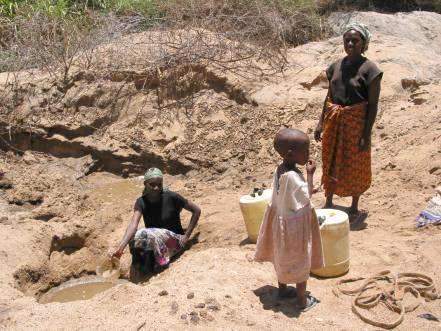

रख-रखाव, मेंटिनेंस
अगर समय से किया जाए तो मरम्मत का काम बहुत महंगा नहीं पड़ता. हालांकि बांध्ध में छोटी-मोटी गड़बडिय़ां भी गंभीर समस्या को जन्म दे सकती हैं. ऐसे में बांध को नियमित रूप से जांचा परखा जाना चाहिए. खासतौर पर बाढ़, तामपान में अतिशय बदलाव आदि की स्थिति में दरारें आ सकती हैं. उनको एक योग्य व्यक्ति के मार्गदर्शन में यथाशीघ्र ठीक किया जाना चाहिए. सूखे दिनों में अगर जलाशय भर गया हो तो बांध की ऊंचाई 50 सेमी तक बढ़ाई जानी चाहिए.
इतना ही नहीं पानी निकासी के जरियों और नदी तट की भी नियमित सफाई की जानी चाहिए. ताकि बांध अवरुद्घ न हो. गाद, पत्थर, मृत पशु आदि को समय-समय पर बाहर निकाला जाना चाहिए ऐसा करने से जल संक्रमण भी नहीं होगा. पानी की गुणवत्ता को समय-समय पर जांचा जाना चाहिए.
रखरखाव का काम आमतौर पर इस्तेमाल करने वाले भी कर सकते हैं. या फिर कोई ऐसा व्यक्ति जो बांध की निगरानी करता हो. बड़ी मरम्मत के काम में कुशल कर्मियों की जरूरत होती है. ये भी स्थानीय स्तर पर मिल जाते हैं. कुछ इलाकों में अकुशल श्रमिकों की आवश्यकता बड़े पैमाने पर हो सकती है. जल उपयोगकर्ताओं को स्थानीय स्तर पर एक समिति बनानी चाहिए जो ऐसे मामलों का ध्यान रखे.
यह समिति पानी पर नियंत्रण उसकी निगरानी, उसे प्रदूषण मुक्त रखने, रखरखाव करने, वित्तीय मदद जुटाने और भंडारित पानी की उपलब्धता सुनिश्चित करने जैसे तमाम काम कर सकती है. पानी का स्तर नापने के लिए पीजोमीटर लगाया जा सकता है या फिर देखरेख करने वाले को यह दायित्व सौंपा जा सकता है कि वह इदस पर नजर रखे कि कितना पानी बचा है. समुचित प्रबंधन करके सामाजिक संघर्ष से भी बचा जा सकताह ै. परिचालन और देखरेख के लिए ऐसे व्यक्ति को चुनना चाहिए जो आसपाास ही रहता हो. यह व्यक्ति पानी के आवंटन के लिए जिम्मेदार हो सकता है और वह निगरानी का काम भी कर सकता है. उसके अधिकार एकदम स्पष्ट होने चाहिए और सभी उपयोगकर्ताओं को उससे संतुष्ट होना चाहिए.
निर्माण, परिचालन और रखरखाव जैसे सभी स्तरों पर सफलता सुनिश्चित करने के लिए स्थानीय समुदाय को समुचित प्रशिक्षण दिया जाना चाहिए ताकि वह बांध का प्रबंधन और उसका रखरखाव कर सके. कैचमेंट स्तर पर नियोजन और प्रबंधन को बढ़ावा दिया जाना चाहिए ताकि विभिन्न समूहों का एक ही स्रोत में निहित स्वार्थ बना रहे. वे मिट्टी और पानी के संरक्षण, खाद्यान्न उत्पादन और स्वास्थ्य सुधार के मसलों पर काम कर सकते हैं. पिछले अनुभवों से यही पता चलता है कि बांध का निर्माण कार्य पूरा होने के बाद समितियां प्रभावी ढंग से काम करना बंद कर देती हैं. बांध निर्माण में ज्यादा समय लिया जाए तो कैचमेंट आधारित संघ बनाने और उसे कामकाज शुरू करने में मदद मिल सकती है.
ब्रिक्की ऐंड ब्रेडरो ने अपने प्रकाशन लिंकिंग टेक्रॉलजी च्वाइस विद ऑपरेशन ऐंड मेंटनेंस इन द कंटेक्स्ट ऑफ कम्युनिटिी वाटर सप्लाई ऐंड सेनिटेशन: अ रिफ्रेंस डॉक्युमेंट फॉर प्लानर्स ऐंड प्रोजेक्ट स्टाफ, में परिचालन और रखरखाव गतिविधियों के लिए निम्र अनुशंसाएं की हैं:
अनुमानित जीवनकाल
यह काफी हद तक निर्माण कार्य में इस्तेमाल की गई सामग्री पर निर्भर करता है. कितुई केन्या में बने बांध 7500 अमेरिकी डॉलर की लागत में बने थे और उनका न्यूनतम जीवनकाल 50 वर्ष है.
लागत
बांध का निर्माण बहुत हद तक स्थानीय समुदाय द्वारा भी किया जाता है. उसकी लागत मुख्यतया, सीमेंट, निर्माण सामग्री और पेशेवर निगरानी में होने वाले खर्च से बनती है.
अनुमानित लागत:
- सामग्री: 5,500 डॉलर
- अन्य लागत: 500 डॉलर
- श्रम: कुशल श्रम 2,500 डॉलर और अकुशल श्रम 900 मानव दिवस -
रखरखाव की लागत:
- परिचालन और रखरखाव : 5 दिन प्रति वर्ष
- केन्या में रेत बांध (सैंडडैम) की लागत बहुत कम थी. 2844 घन मीटर पानी वाला बांध 3,260 डॉलर में बना. यानी 1.15 डॉलर प्रति घन मीटर भंडारण.
- पहले साल के इस्तेमाल में इसका लागत लाभ अनुपात 1: 12 का रहा.
जमीनी अनुभव
केन्या में कितुई, मचाकोस और सांबरू जिलों में इसके अच्छे नतीजे सामने आए. अन्य देशों में मसलन अमेरिका, थाईलेंड, इथोपिया और नामीबिया में भी विविध रूपों में इसका इस्तेमाल किया गया.
कितुई जिला, केन्या: सासोल फाउंडेशन ने सन 1995 से अब तक वहां 500 से अधिक बांध बनाए. उनका निर्माण स्थानीय सामग्री से किया गया और आंशिक तौर उसका वित्त पोषण भी स्थानीय समुदाय ने किया. यह राशि करीब 40 फीसदी थी. स्थानीय समुदाय निर्माण और रखरखाव में भी शामिल रहा. रेत प्रबंधन समूह स्थापित कर निर्माण और रखरखाव में मदद मुहैया कराई गई.
ये बांध न केवल पेयजल को स्थायित्व देते हैं बल्कि इनके अन्य सामाजिक आर्थिक लाभ भी हैं. वे नकदी फसलों के लिए सिंचाई सुविधा मुहैया कराते हैं और अन्य ग्रामीण गतिविधियों के लिए भी लाभदायक साबित होते हैं. इनकी वजह से एक बड़े क्षेत्र में जल स्तर बढ़ता है और इसतरह पर्यावास को फायदा पहुंचता है.
बोराना जोन, इथोपिया: इस क्षेत्र के समुदाय व्यापक तौर पर कृषि और पशुपालन पर निर्भर हैं. पानी में अस्थायित्व होने के कारण यह काम बहुत सीमित पैमाने पर होता रहा. वर्ष 2007 में कई स्वयंसेवी संगठनों ने 7 रेत बांध (सैंडडैम) और 10 टैंक बनाए. इसकी वजह से क्षेत्र के 10 समुदायों को पानी का विश्वसनीय स्रोत हासिल हुआ. भविष्य में इस परियोजना को देश के अन्य हिस्सों में ले जाया जाएगा.
Akvo RSR Projects
The following project utilize sand dams.
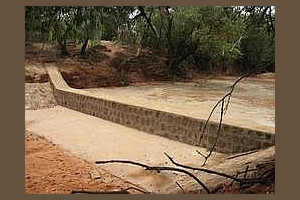 Dawa Eresa Subsurface and Sand Dam project |
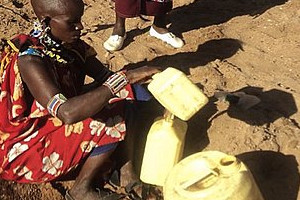 Feasibility Study for Rainwater Harvesting |
 Wateroogst: Konso Woreda/Eshimale |
नियमावली, वीडियो और लिंक
- मैनुअल: रेत बांध (सैंडडैम) क्रियान्वयन पर एक व्यावहारिक गाइड. वर्षा जल संरक्षण क्रियान्वयन नेटवर्क (आरएआईएन).
- मैनुअल: इथोपिया में रेत बांध (सैंडडैम) पर मैनुअल: रेत बांध (सैंडडैम) के लिए स्थान चयन, डिजाइन और निर्माण को लेकर व्यावहारिक रुख, रेत बांध (सैंडडैम) को अन्य वर्षाजल संरक्षण ढांचों से मिलाने का उपाय. ईआरएचए (इथोपिया रेनवाटर हार्वेस्अिंग एसोसिएशन) और आरएआईएन फाउंडेशन.
- मैनुअल: बिफोर द डल्ज: बदलती जलवायु के बीच बाढ़ से निपटने की कोशिश. जलवायु परिवर्तन के कारण आई बाढ़ से कैसे निपटें. इंटरनैशनल रिवर्स नेटवर्क .
- मैनुअल: रेत बांध (सैंडडैम): शुष्क और अद्र्घ शुष्क क्षेत्रों में प्रभावी वर्षा जल संरक्षण तकनीक. व्यावहारिक प्रयास.
- डॉक: FAQs on Sand Dams. Provided by Excellent/ASDF with input from Dabane Trust.
वीडियो लिंक
& field visit in Ethiopia, 2009 |
Project - Kenya, 2010 |
लिंक्स
- एक्स्लिेंट पायोनियर्स ऑफ सैंड डैम.
- एसीएसीआईए वाटर. एसीएसीआईए वाटर को भूजल के क्षेत्र में विशेषज्ञता हासिल है. जबकि साथ ही साथ वह चीजों को व्यापक नजरिये से भी देखती है और उन्हें अन्य क्षेत्रों से संबद्घ करती है. परिणामस्वरूप हम अक्सर व्यापक विशेषज्ञता के साथ बहुआयाती माहौल में काम करते हैं.
- आईएएच. आईएएच-एमएआर एक ऐसा मंच है जो अंतरराष्ट्रीय भूजल समुदाय के साथ मिलकर भूजल रिचार्ज, प्रबंधन और जल स्रोत रिचार्ज बढ़ाने को लेकर काम करता है. यह दुनिया के भूतल जल संसाधनों के प्रबंधन का स्थायी उपाय है.
संदर्भ-आभार
- केयर नीदरलैंड, डेस्क स्टडी, शुष्क इलाकों में नम्य डब्ल्यूएएसएच. अक्टूबर 2010
- ब्रिक्के, फ्राक्वा और ब्रेडो, मार्टिन. लिंकिंग टेक्रॉलजी च्वाइस विद ऑपरेशन ऐंड मैंटनेंस इन द कंटेक्स्ट ऑफ कम्युनिटी वाटर सप्लाइ ऐंड सैनिटेशन: अ रिफ्रेंस डॉक्युमेंट फार प्लानर्स ऐंड प्रोजेक्ट स्टाफ अथवा (वैकल्पिक लिंक). विश्व स्वास्थ्य संगठन और आईआरसी वाटर ऐंड सेनिटेशन सेंटर. जेनेवा, स्विटजरलैंड 2003.
- मैड्रेल एस ऐंड नील आई, सैंड डैम: अ प्रैक्टिल गाइड, एक्सिलेंट डेवलपमेंट, लंदन, 2012
- जैकब एच स्टर्न, पीएचडी ऐंड अल्वेरा स्टर्न ईडी.डी. वाटर हार्वेस्टगिं थ्रो सैंड डैम्स. ईसीएचओ टेक्रिकल नोट. 2011
